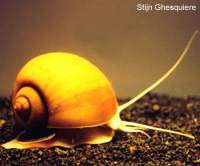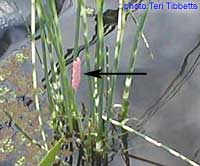 Common
Name: Apple Snail (Golden Apple Snail, Channeled
Apple Snail)
Common
Name: Apple Snail (Golden Apple Snail, Channeled
Apple Snail)
Scientific Name: Pomacea canaliculata
Classification:
Phylum or Division: MolluscaIdentification: Pomacea canaliculata looks very much like congeneric species. They have rounded whorls at the top, with deeply indented sutures. It is distinguished from other Pomacea species in the aquarium trade by the indented shell sutures which meet at an angle of less than 90 degrees. Its shell is rounder than the P. bridgesi shell. It has a more prominent apex than the Florida apple snail, P. paludosa. Color may not be used to identify the species as it varies from yellow and green to brown with or without dark spiral bands. Size cannot be used either, as food availability affects size (They generally grow to about 10 cm).
Class: Gastropoda
Order: Mesogastropoda
Family: Ampullariidae
In Australia, P. bridgesi snails are common for aquariums as they do a nice job of keeping the tank walls clean. They are often sold as “mystery snails.” It is worrisome for officials because P. canaliculata looks so similar, but is far more destructive. If this snail gets to Australia and is released to wetland habitats, it would do considerable ecological and agricultural damage.
Original Distribution: Pomacea canaliculata is originally from Argentina, Bolivia, Brazil, Paraguay and Uruguay.
Current Distribution:Pomacea canaliculata is currently found in the Philippines, Japan, Korea, Taiwan, Vietnam, Cambodia, Laos, Papua New Guinea, parts of Indonesia and Malaysia, Singapore, southern China, and Guam. It is also found in the Dominican Republic, Hawai`i (all islands except Molokai and Lani), Florida (Hillsborough, Collier, and Palm Beach counties), Texas (Cameon and Harris counties), and California. In Florida and Texas, snail populations likely began with unwanted aquarium snails.
Site and Date of Introduction: In 1980, the apple snail was introduced to south-east Asia as a food item and aquarium pet. First, it was introduced to Taiwan, then Japan, then Thailand and the Philippines. Instead of catching on, snails were released or escaped. It was introduced to Hawaii in 1989, probably from the Philippines, as a food source, where it also escaped or was released to become a major agricultural pest. It is found in Texas, California (rice-growing states) and also Florida.
Mode(s) of Introduction: The snail was imported legally for developing aquaculture for human food. It then was moved to different bodies of water for establishing aquaculture. Some snails escaped; others were likely deliberately released.
Apple snails are also part of the aquarium trade, and bred to sell to pet stores. Similarly, these snails were released or escape. It’s also very likely that snail eggs or small snails attached to aquatic plants found their way into new water sources. Smuggling of snails, especially for the food trade, is another way snails enter a country, where they are introduced to wetland areas in hopes of raising them as a food item. Snails are dispersed easily with water currents.
Reason(s) Why it has Become Established: Pomacea canaliculata has a high rate of reproduction and is extremely tough. Clutches are laid every few weeks and may contain up to 1200 eggs (although 200-300 is more usual). Hatchlings are voracious feeders, grow quickly (maturing at about 2 months old), and live for about four to six years.
Apple snails may estivate for up to 5 months of the year, meaning that even with drought conditions or imposed drying, they will likely survive. Their tolerance to pollution and low oxygen levels is high. They are able to live on many different types of plant matter, as well as decomposing organic matter. They have been called “eating machines” because they can eat 24 hours a day. They have an affinity for crops such as rice and taro.
Ecological Role: Apple snails are herbivores with a wide menu (rice seedlings, taro, duck weed, water hyacinth, algae, azolla, and other succulent leafy plants). They prefer young, soft plants. They will eat eggs and juveniles of other snails. They also eat decomposing organic matter.
They may provide food for natural predators such as ants, dragonflies, birds, spiders, field rats, and fish. Some of these animals are intentionally introduced, such as carp or ducks, as few natural predators may be present in the snails’ new home.
Benefit(s): The apple snail is eaten by people and animals, and used in aquariums, but not to the beneficial extent intended. It now has no commercial value as a food source.
Sedentary and sensitive by nature, aquatic snails are good bio-indicators for water pollution such as pesticides and trace metals, if anyone wants to use them that way.
One “success story”, which called the apple snail a “golden goose”, was a project by an undergraduate student in the Hawai`ian community of Keanau-Wailuanui. The student was studying food habits of the snail, and developed improved food and rates for a gourmet-quality snail. Snails were removed from the taro fields they were destroying. The article by the sponsor of the research, Hawaii Sea Grant, said that in the community of 35% unemployment, “the cash flow has enabled the community association to promote their cultural, educational, and economic goals.” This was the exception to the rule, in which most communities cursed the snail and suffered economic losses.
 Threat(s):
Over half (1.2 to 1.6 million hectares) of rice fields in the Philippines
are infested with the golden apple snail. The damage and economic
loss have been devastating. Snails consume the base of rice seedlings
and feed on new transplants. The costs of controlling the snail,
replanting, and rice yield loss all account for economic loss.
Threat(s):
Over half (1.2 to 1.6 million hectares) of rice fields in the Philippines
are infested with the golden apple snail. The damage and economic
loss have been devastating. Snails consume the base of rice seedlings
and feed on new transplants. The costs of controlling the snail,
replanting, and rice yield loss all account for economic loss.
Beyond these costs are the costs associated with damaging the ecosystem. Snails destroy plants and affect the food web. They may easily out-compete native species. They have helped in the decline of native Pila apple snails in south-east Asia.
Climatic modeling has shown that they have potential to spread to yet-uninfested parts of the world, including India and Australia, which would suffer hugely.
Human health threats are also associated with this species. It may be a vector for disease and parasites such as the lungworm, which may cause the fatal eosinophilic meningoencephalitis disease in humans. Snails also contribute to skin irritations by being intermediate hosts to the associated trematodes. Pesticide side-effects include blurring vision and blindness, skin problems, and loss of nails.
Control Level Diagnosis: This species is one of the 100 world’s worst invaders, according to the Global Invasive Species Database.
It would earn the designation “highest priority” based on its large distribution in many countries, potential to destroy crops and harm people. Stopping its spread with stricter controls and also education would be a priority.
Control Method: Biological control methods have been tried, including ducks, fish such as carp and Nile tilapia, and red ants (which feed on eggs). Some plants with toxic substances, if grown in the rice paddies, or left floating near the snails, will kill them. In two small areas in Kedah, Malaysia, a plant product pesticide and brackish water successfully controlled snails.
The most effective control method seems to be hand-picking the snails, but this is a labor-intensive method. It is suggested to use certain plant attractants or old newspapers or build shallow canals to get greater concentrations of snails to remove. Screens on water inlets may prevent the spread of snails to new paddies. Water control has met with limited success.
In a handbook written for farmers with problem apple snails in the Philippines, a recipe for cooking snails was even included! It made a crispy, long-lasting treat flavored with soy sauce, garlic, and chili.
Several pesticides and molluscicides have been tried. As well as the costs, they are harmful to other species, including humans. Long-lasting effects on ecosystems may not be known for years. No chemicals are currently known to be safe, effective and cheap enough to use on a large scale, although various ones are in use, including ones which have been banned in countries such as Japan, Taiwan and the Philippines.
Genetic manipulation to produce snails which reproduce less is also under consideration.
It is felt that eradicating snails from areas where they are well-established is almost impossible.
References:
Apple snail website: www.applesnail.net. Includes an extensive bibliography on the apple snail.Illustrations:Apple Snails in Wetland Taro Production http://agrss.sherman.hawaii.edu/onfarm/pest/pest0008.html
CSIRO media release – Halting the Snail Trail of Destruction, www.csiro.au/news/mediarel/mr1998/mr98241.html
Global Invasive Species Database: www.issg.org/database/species/list.asp
Hawaii Sea Grant: www.sg.ohio-state.edu/publications/ANSreport/pacific.pdf
Pomacea canaliculata, http://lionfish.ims.usm.edu/~musweb/nis/Pomacea_canaliculata.html
Socio-Economic Aspects of Biological Invasion, A Case Study: the Golden Apple Snail www.gcrio.org/ASPEN/science/eoc94/EOC3/EOC3-18.html
The Biology and Ecology Studies of Aquatic Macroinvertebrates and Their Enemies in Rice Field www.fsas.upm.edu.my/~stshasan/jha.html
Snails, rice paddy damage and eggs, from: Pomacea canaliculata Pest alert poster www.applesnail.net